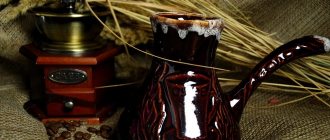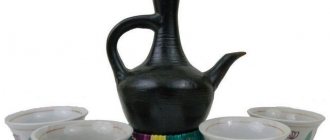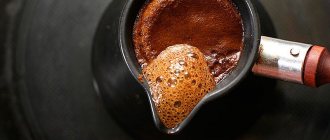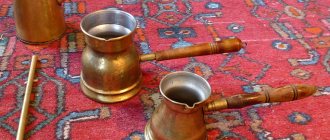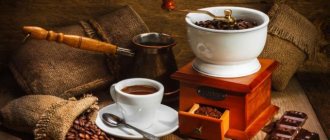Let me tell you right away that this recipe is for home use. The Turk is heated on a regular electric or gas stove, without any quartz sand. However, even at home we will try to correctly repeat all the key principles of cooking. And at the same time, let’s compare our grandmothers’ recipe and how coffee is brewed in Turkey.
How to choose Turkish coffee
The right variety
Classic recipes were created at a time when coffee conquered Africa, Asia and began its victorious march across Europe. There was no talk of any robusta back then: the drink was brewed only from Arabica beans. Nowadays there are sometimes tips to use robusta for making coffee. Everyone decides for themselves whether it is worth experimenting with this type of grain.
Pure Arabica is the best option for brewing in a Turk
There are three serious reasons not to make Turkish coffee from pure robusta or blends that contain it:
- Robusta is very bitter, and in the process of preparing coffee in Turk, the bitterness intensifies;
- Coffee brewed in a Turk is valuable not only for its taste, but also for its aroma. However, the smell of Robusta is not nearly as intense and rich as that of Arabica;
- Robusta has a higher caffeine content than Arabica. Robusta coffee made in Turk will be invigorating, but too strong, and will turn into a time bomb for the heart and blood vessels.
There are many Arabica varieties on sale with different aromas and tastes, so a coffee lover has nothing to lose by giving up Robusta.
How to prepare grains
Rules for choosing coffee beans for brewing in a Turk:
- The roasting of the beans should be no darker than medium (Viennese). A drink that is more deeply roasted turns out to be unbearably bitter and tastes and smells like an infusion of something burnt;
- The stronger the roast, the more bitterness and minimum sourness you feel in the finished drink. Brewing in a Turk further neutralizes the sour taste. Therefore, lovers of sourness should choose very light roasted beans;
- You shouldn’t chase elite varieties with a rich aftertaste. To brew Turkish coffee, it is enough to purchase high-quality Arabica coffee with a mild taste, for example, Kenyan coffee.
Grinding Turkish coffee
The advice to grind coffee yourself is not a quirk of the originals. Inside the coffee beans there are voids filled with essential oils. Grinding the coffee releases the aroma. The more time has passed since grinding, the weaker the smell.
It is recommended to store ground coffee from an open pack in a glass container with a sealed lid and use it within 2-3 weeks. When purchasing coffee in a specialty store, you need to take a small amount and not stock up for future use.
The best option for cezve is freshly ground grains. A lot of things have been broken regarding the degree of grinding. To make Turkish coffee, any grind is suitable, only the taste will be different. The finer the grind, the faster the extraction. A drink made from finely ground grains will be stronger than one made from coarsely ground grains.
Correct grinding
The best option is medium and fine grinding. Although ultra-fine grinding (to dust) is advertised as the most suitable for Turkish coffee, handling coffee powder ground “to dust” is difficult: it forms a suspension in the finished drink, and you have to wait for it to settle. It is recommended to use ultra-fine grind coffee only when all coffee brewing techniques have already been mastered and brought to perfection.
Learning to choose a Turk
A turka, or as it is also called a cezve, is a vessel made of metal. It has a narrowed neck and a long handle - wooden, metal, ceramic. People began to use such utensils since grains were discovered in the East, from which an incredibly invigorating, aromatic and tasty drink was obtained.
Thanks to the wide bottom of the vessel, the contents are heated evenly; the narrow neck speeds up the process of settling the grounds during cooking. A long handle is necessary to avoid getting burned by the fire.
Previously, containers for preparing such drinks were made of clay and ceramics. However, over time it turned out that such materials are too fragile, so today Turks rarely make them from them.
The main disadvantage of clay and ceramic pots is their high heat capacity, due to which the contents continue to cook even when the vessel has already been removed from the heat. Hence, overcooked coffee and the surface of the table or stove stained with escaped foam.
Stainless steel pots do not emit harmful substances, they are durable and not expensive. But the problem is that such material heats up unevenly, and the bottom of the vessel heats up much faster than the walls, which leads to burning of coffee oils. The taste of the finished drink is imperfect.
Containers made of aluminum are not expensive, have high strength characteristics and good thermal conductivity. However, their use in coffee making is not recommended, since aluminum can react with any product and can cause harm to health.
The ideal material for making Turks is copper. It is not only attractive in appearance, but also has high thermal conductivity. The water in the Turk, made of copper, is heated evenly and is not brought to a boil. Well, so that the contents do not enter into a chemical reaction with the metal, the inner surface of the copper Turks is coated with tin.
Silver also has identical characteristics. But cezves made of silver are expensive and many coffee lovers cannot afford them.
Water for coffee
Chlorine is a taste killer, so untreated tap water is generally not suitable for making coffee. You can completely remove chlorine from water using a home carbon filter. The ozonizer also cleans water well from chlorine.
If there is no filter or ozonizer, then as a last resort it is allowed to brew coffee in a Turk using boiled and settled tap water. However, there are still too many impurities that impair the taste, so it is better to use bottled, spring or well water.
The chemical composition and acidity of the water are very important for the taste of the future drink. The fact is that coffee is rich in acids. If brewed in too alkaline water, the taste will lose its richness and fade. The ideal acidity of water for Turkish coffee is pH 7.0, but water with an acidity in the pH range of 6.5 – 7.5 is also suitable.
In water that is too soft, the extraction process is unstable; in water that is too hard, the flavors disappear. The permissible range of water mineralization (the total number of dissolved particles, this parameter is usually indicated on the bottle label) is 75–250 mg/l. The best water is considered to have a mineralization of 120–150 mg/l, a calcium content of 17–85 mg/l and sodium content of no more than 30 mg/l.
Useful article: how to choose a Turk.
Useful video
From this video you will learn more about how to properly brew coffee in a Turk using gas:
Despite the popularity of modern electric coffee makers and automatic coffee machines, classic cezves for making coffee on a gas stove do not lose their relevance and are in great demand among lovers of delicious black coffee .
If desired, you can add various syrups, honey or other fillers to your usual drink, which will further diversify your coffee with new flavors and aromas.
Classic Turkish coffee recipe
Proportions
When brewing, the optimal proportion of Turkish coffee is 1:10 (1 part ground beans to 10 parts water), that is, 10 g of coffee will be needed per 100 g of water. However, here everyone decides for himself: some people like a stronger drink, others a weaker one. Other ingredients: sugar, milk, honey, spices, etc. are not used in the traditional version.
Step-by-step cooking technology
- Pour coffee into the cezve (add sugar and other bulk ingredients if desired), pour in half of the water at room temperature.
- Wait until the coffee stops releasing air bubbles (“blooming”).
- Add the rest of the water into the Turk, in which you have previously diluted the remaining liquid ingredients, for example, milk or honey (optional). The liquid level should not be higher than the narrowing of the neck, otherwise the foam will splash out when heated.
- Place the Turk on the stove burner, turning on the lowest heat. If you have time, you can hold the Turk in your hand over the fire.
- After a minute, stir the contents of the vessel so that there are no lumps left in the coffee. Subsequently, do not stir again.
- Attention! Under no circumstances should the coffee be allowed to boil. As soon as the foam in the Turk begins to rise (this happens at a temperature of 95–96 °C), the coffee along with the grounds should be poured into a preheated cup.
- It will take approximately 2-3 minutes for the extraction process to complete and the grounds to settle. After this, coffee is served to the table.
The Turkish coffee recipe given is basic. By experimenting with the initial temperature of the water in the Turk (from ice-cold to moderately warm), the degree of grinding and frying, you can achieve a signature, unique taste.
Cook properly until a stable foam appears.
Helpful Tips:
- In order for the aroma and taste of coffee to be revealed more fully, a little table salt (necessarily not iodized) is placed in the Turk along with ground coffee: literally on the tip of a knife. The taste of salt will not be felt in the finished coffee;
- To enhance the aroma of ground coffee, it is sometimes recommended to heat it in a Turk before adding water. This must be done extremely carefully so that the powder does not char. It is better not to roast ultra-fine ground coffee;
- if you want to brew coffee with sugar or spices, then all dry additives are mixed with ground coffee before it is poured with water. Liquid ingredients (for example, syrups or honey) are dissolved in water in advance;
- the coffee must not be allowed to boil or the foam to splash out: then the drink will lose both taste and aroma;
- Coffee brewed in a Turk must be served with a glass of water at room temperature: a sip of water will allow you to cleanse your receptors and more fully enjoy the taste of the drink.
How to replace Turk
Coffee is brewed in a Turk or cezve, but what to do if you don’t have them on hand? Cook in a saucepan? Why not? Just take an enameled one and a small one. You can also use coffee makers. Since the times of the Soviet Union, they have been produced in a great variety of types and modifications.
Some gourmets claim that a ceramic pot is not inferior to a traditional Turkish pot, but it is inconvenient to use. As a rule, pots do not have handles.
Another way is the microwave. But here you need to know the exact boiling time of the water in the cup and set the time a little less so that the coffee does not run away.
Arabic coffee
Recipe:
- Pour a teaspoon of sugar (to taste) into a preheated Turk.
- Over low heat, bring the sugar to a light brown color (before caramelization begins).
- Pour 100 ml of water over caramelized sugar and bring to a boil.
- Remove the cezve from the heat, add 10 g of ground coffee, stir.
- Pour in 1 tablespoon of cold water.
- Heat over low heat.
- As soon as the foam rises, remove the Turk from the heat.
- After 2-3 minutes, pour the coffee into heated cups.
You can add a pinch of cardamom or a pinch each of cardamom and cinnamon to the drink prepared according to this recipe. Specialized stores sell real Arabic coffee with cardamom.
Cooking time
The time to prepare a drink on gas depends on the quality of the Turk, the size of the burner, the strength of the fire, the density of the coffee powder and the ingredients added.
The process of brewing one serving of a classic drink in a standard volume device (100 ml) over low heat takes no more than 7 minutes .
Cooking cannot be too fast, because in this case the drink will reach a boil in just a couple of minutes, without having time to be enriched with the aromatic and taste qualities of natural ground grains.
For your information! Slow heat promotes long and intense extraction, which means the finished drink will have a rich taste and pleasant aroma.
Viennese coffee
Ingredients for one serving:
- 35 ml black coffee brewed in Turkish;
- 20 ml cream;
- 3–5 g dark chocolate;
- sugar - to taste.
Recipe: brew coffee in a Turkish coffee pot in the traditional way. While the grounds are settling in the cezve, whip the cream and sugar until stiff peaks form. Pour the coffee into a warm cup, pour the cream on top and sprinkle it with chocolate. Serve with a sugar bowl or sticker, but additional sugar is generally not needed.
How to determine the degree of readiness of a drink?
To understand exactly how long the drink takes to prepare and determine the moment when the coffee is completely ready and needs to be removed from the heat, it is important to carefully monitor the process of formation and rise of foam . It is also worth paying attention to the fact that after removing the vessel from the fire for the first time, the procedure must be repeated twice. The liquid should not rise above the neck or spill .
The drink will be ready for drinking once the formed foam begins to move upward again.
At this moment, you need to ensure that the dense foam that prevents contact of the drink with air does not violate its integrity .
Coffee prepared in Turk produces a pleasant aroma, is not bitter and has a bright, rich taste, which is also a sign that the drink was brewed according to all the rules.
Coffee with honey
Recipe:
- Dissolve honey in warm water (to taste, 0.5–1.5 tsp per 100 ml of water).
- Pour ground coffee into a Turk, add water and honey, then prepare using the same method as Turkish coffee.
To improve the taste, add a pinch of cinnamon, cardamom, ginger or other spices to ground coffee. The drink turns out to be very filling (calorie content of 100 ml is about 300 kcal), gives strength and satisfies hunger, so Turkish coffee with honey is good before exams or sports training.
What is a Turk and types of Turks
Turka is the general name for a ladle for brewing coffee. Since this tradition came from Turkey, that’s why the Turk was called that.
An ancient version called ibrik. It is a jug with a long spout and handle.
This vessel originally served as a water jug. It was made of copper or clay, depending on who owned it. The rich kept copper jugs, and the poor, respectively, clay ones.
To be more precise, the first vessel or container for cooking was a simple cauldron. In ancient times, coffee was prepared by residents of various African tribes. But one day, desert Bedouin tribes met with southern African nomads and took from them the tradition of drinking coffee. But they didn’t like the cooking pot and used their own jug, ibrik, for this purpose. The drink prepared in it turned out to be more rich and tasty. As a result, the ibrik began to change not only its shape, but also its name.
This is how another type of coffee pot appeared - jebena. It is still used in Ethiopia.
Jebena is made mainly of ceramics. It differs from the Ibrik by its small nose. Otherwise, there are no significant differences. The only thing is that horsehair is placed at the base of the spout as a filter. This way the grounds remain in the container and do not end up in the cup.
But as times passed, methods of making coffee changed, many different options appeared, and ibrik also did not remain unchanged. In the Middle East, coffee lovers came up with a completely different brewing vessel called the dallah. This jug had a wide bottom and rounded sides, which sharply tapered towards the top. The dalla also had an unusual shape.
The neck of the dalla is wider than that of the ibrik, and so that the drink does not cool down for a long time, the jug is closed tightly with a lid.
For ease of cooking, the dallah was made with a round and long handle.
However, the dalla was made in different and unusual configurations. For example, this “four-legged” coffee pot.
The dalla was made mainly of brass, and for rich Arabs - of gold. Naturally, a beautiful pattern was also applied to the jug.
And finally, there is another option, which is the most popular - this is a cezve. It has an oblong shape with a wide bottom and a long handle. This form preserves the taste and aroma of coffee.
Translated from Turkish, the name “cezva” means “hot coal”. Traditionally, coffee is prepared over charcoal, hence the name. When the cezve appeared in Russia, its name seemed somewhat difficult to pronounce and such a coffee maker was renamed Turk, since the recipe for making Turkish coffee was popular at that time. This name has survived to this day.
The cezve or Turk differs from its predecessors not only in shape, but also in size. When the Turkish Sultan decided to drink such a strong drink all the time, but for him one large coffee pot in the form of ibrik was too much. Then they reduced it to the size of one serving. Since then, such a small ladle has become popular for preparing a one-time drink.
Traditionally, the cezve is made of copper. However, you can buy a Turk made from stainless steel, clay and even glass.
Of course, copper Turks are considered the best for making coffee, but other materials can also be used.
But if you are buying a Turk to make delicious and aromatic coffee, it is better to take a copper one. In addition, it should have a narrow neck and a stable bottom. The inner surface of the Turk should be uniform without flaws. Since recipes for coffee made in a Turk are designed for one cup, you need to select the same volume of Turk. However, the volume of Turka depends on how many people you are cooking for.
When cooked in a Turk, its taste depends on many reasons. This could be the water itself (its composition, hardness), the grinding of coffee beans, the time during which the Turk is heated.
The choice of variety is also important. Arabica is recommended as the best variety for brewing Turkish coffee.
In addition, grinding also plays an important role. The smaller the grind, the more aromatic the coffee will be. It is best when different degrees of grinding are mixed. The most suitable is a mixture of medium and fine grinding.
And finally, another component on which taste and aroma depends is water. It is best to use bottled water. If there is none, then only boiled water is taken.
So, when everything is ready, you can start cooking.


